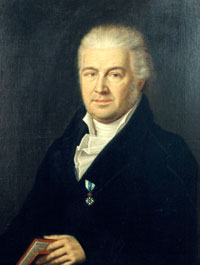Samuel Thomas von Sömmerring
This article has multiple issues. Please help improve it or discuss these issues on the talk page. (Learn how and when to remove these template messages)
|
Samuel Thomas von Sömmerring | |
|---|---|
 Portrait by Wendelin Moosbrugger | |
| Born | 28 January 1755 |
| Died | 2 March 1830 (aged 75) |
| Nationality | German |
| Alma mater | University of Göttingen |
| Scientific career | |
| Fields | medicine |
| Doctoral advisor | Ernst Gottfried Baldinger |
Samuel Thomas von Sömmerring (28 January 1755 – 2 March 1830) was a German
Career

Sömmerring was born in
When Sömmerring was 23 years old he described the organization of the cranial nerves as part of this doctoral work: its study is still valid today. He published many writings in the fields of medicine, anatomy and neuroanatomy, anthropology, paleontology, astronomy and philosophy. Among other things he wrote about fossil crocodiles and in 1812 he described Ornithocephalus antiquus now known as Pterodactylus. He was also the first to accurately draw a representation of the female skeleton structure.
In addition, Sömmerring was a very creative inventor, having designed a
Sömmering was married to Margarethe Elizabeth Grunelius (deceased 1802), and had a son, Dietmar William, and a daughter, Susanne Katharina. Due to bad weather, Sömmering left Munich in 1820 and returned to Frankfurt, where he died in 1830. He is buried at the city's main cemetery.
A subspecies of the
Works
- Über die körperliche Verschiedenheit des Mohren vom Europär (1784)
- Vom Hirn- und Rückenmark (Mainz 1788, 2. Aufl. 1792);
- Vom Bau des menschlichen Körpers (Frankfurt am Main 1791–96, 6 Bde.; 2. Aufl. 1800; neue Aufl. von Bischoff, Henle u. a., Leipzig 1839–45, 8 Bde.);
- De corporis humani fabrica (Frankfurt am Main 1794–1801, 6 Bde.);
- De morbis vasorum absorbentium corporis humani (Frankfurt am Main 1795);
- Tabula sceleti feminini (Frankfurt am Main 1798);
- Abbildungen des menschlichen Auges (Frankfurt am Main 1801),
- Abbildungen des menschlichen Hörorgans (Frankfurt am Main 1806),
- Abbindungen des menschlichen Organs des Geschmacks und der Stimme (Frankfurt am Main 1806),
- Abbildungen der menschlichen Organe des Geruchs (1809).
The exchange of letters between Sömmering and Georg Forster was published by Hettner (Braunschweig, 1878)eben.
Bibliography
- Klemme, H.; Kuehn, M., eds. (2016). "Samuel Thomas von Soemmerring (1755–1830)". The Bloomsbury dictionary of eighteenth-century German philosophers. Continuum. pp. 727–730.
- Wagner, R. Sömmerings Leben und Verkehr mit Zeitgenossen (Leipzig 1844).
References
- ^ Fischer, G. (1811). "Notice sur la Choucas de la Russie". Mémoires de la Société Impériale des Naturalistes de Moscou (in French). 1: 3. Retrieved 2019-02-20.
